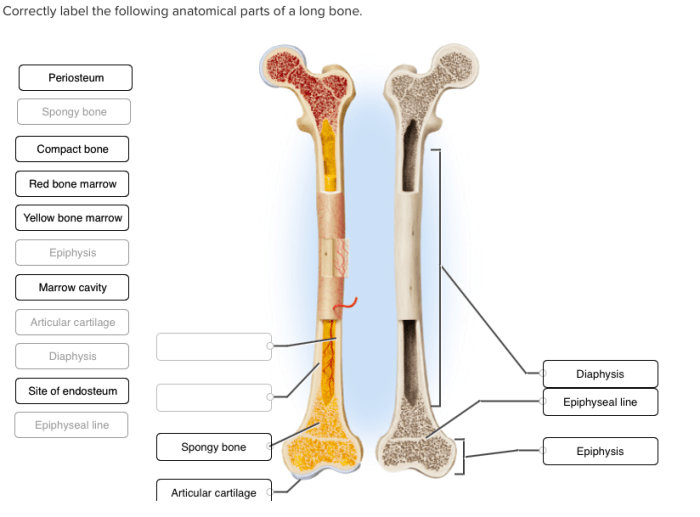Correctly label the following anatomical parts of a long bone. – Correctly label the following anatomical parts of a long bone: the diaphysis, epiphysis, metaphysis, articular cartilage, periosteum, endosteum, nutrient foramen, and medullary cavity. Understanding the anatomy of long bones is crucial for comprehending their function and role in the skeletal system.
This guide provides a comprehensive overview of each anatomical part, including its structure, location, and significance.
Long bones, characterized by their elongated shape, are found in the limbs and play a vital role in movement, support, and protection. By accurately labeling their anatomical components, we gain a deeper appreciation for the intricate design and functionality of the human body.
Introduction: Correctly Label The Following Anatomical Parts Of A Long Bone.

A long bone is a type of bone that is longer than it is wide. Long bones are found in the limbs, fingers, and toes. They are made up of a shaft, or diaphysis, and two ends, or epiphyses. The diaphysis is the long, cylindrical part of the bone.
The epiphyses are the rounded ends of the bone.
It is important to correctly label the anatomical parts of a long bone because it helps us to understand how the bone functions. For example, the diaphysis is responsible for providing strength and support to the bone, while the epiphyses are responsible for providing cushioning and allowing for movement.
Diaphysis, Correctly label the following anatomical parts of a long bone.
The diaphysis is the long, cylindrical part of the bone. It is made up of compact bone, which is a dense type of bone that provides strength and support. The diaphysis is also home to the medullary cavity, which is a hollow space that contains bone marrow.
Bone marrow is a soft tissue that produces red blood cells, white blood cells, and platelets.
Epiphysis
The epiphyses are the rounded ends of the bone. They are made up of cancellous bone, which is a less dense type of bone that provides cushioning and allows for movement. The epiphyses are also covered in a layer of articular cartilage, which is a smooth, white tissue that helps to reduce friction between bones.
Metaphysis
The metaphysis is the region of the bone that connects the diaphysis to the epiphysis. It is made up of a mixture of compact and cancellous bone. The metaphysis is responsible for providing strength and support to the bone, while also allowing for some movement.
Articular Cartilage
Articular cartilage is a smooth, white tissue that covers the ends of the bones. It helps to reduce friction between bones and allows for smooth movement. Articular cartilage is made up of a type of cell called a chondrocyte, which produces a matrix of collagen and proteoglycans.
Periosteum
The periosteum is a tough, fibrous membrane that covers the outside of the bone. It is responsible for providing nutrients to the bone and for protecting it from damage. The periosteum also contains cells that can repair damaged bone.
Endosteum
The endosteum is a thin membrane that lines the inside of the medullary cavity. It is responsible for producing new bone cells and for regulating the flow of blood to the bone.
Nutrient Foramen
The nutrient foramen is a small hole in the diaphysis of the bone. It allows blood vessels and nerves to enter the bone.
Medullary Cavity
The medullary cavity is a hollow space in the diaphysis of the bone. It contains bone marrow, which is a soft tissue that produces red blood cells, white blood cells, and platelets.
Essential FAQs
What is the diaphysis of a long bone?
The diaphysis is the main shaft of a long bone, providing structural support and protection for the bone marrow.
Where is the epiphysis located?
The epiphysis is the rounded end of a long bone, responsible for forming joints with other bones.
What is the function of the metaphysis?
The metaphysis is the region between the diaphysis and epiphysis, facilitating bone growth and development.

